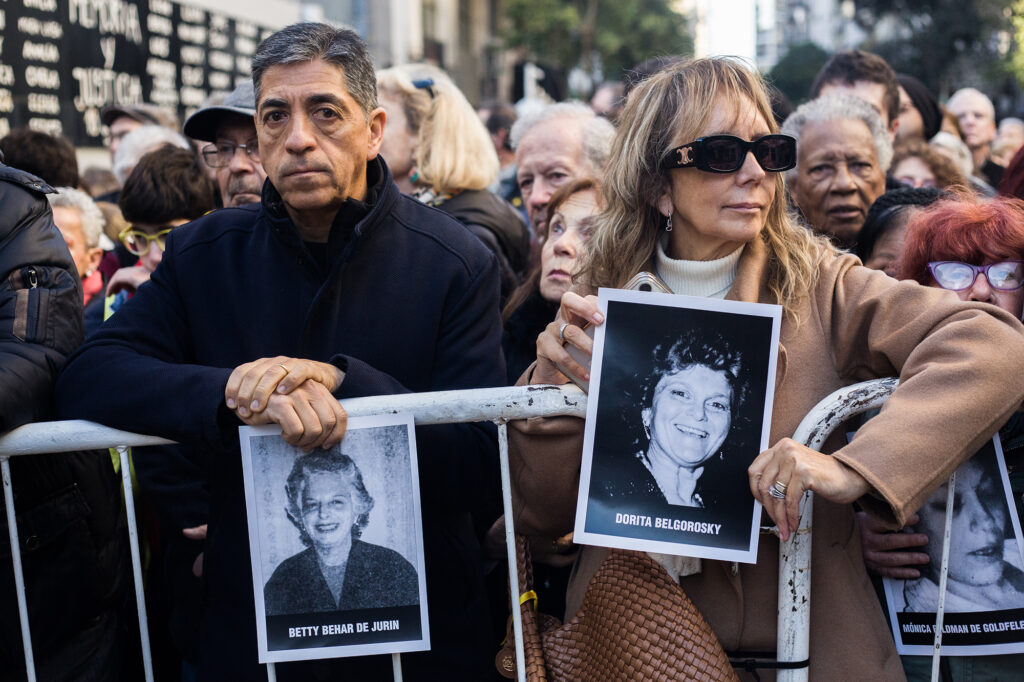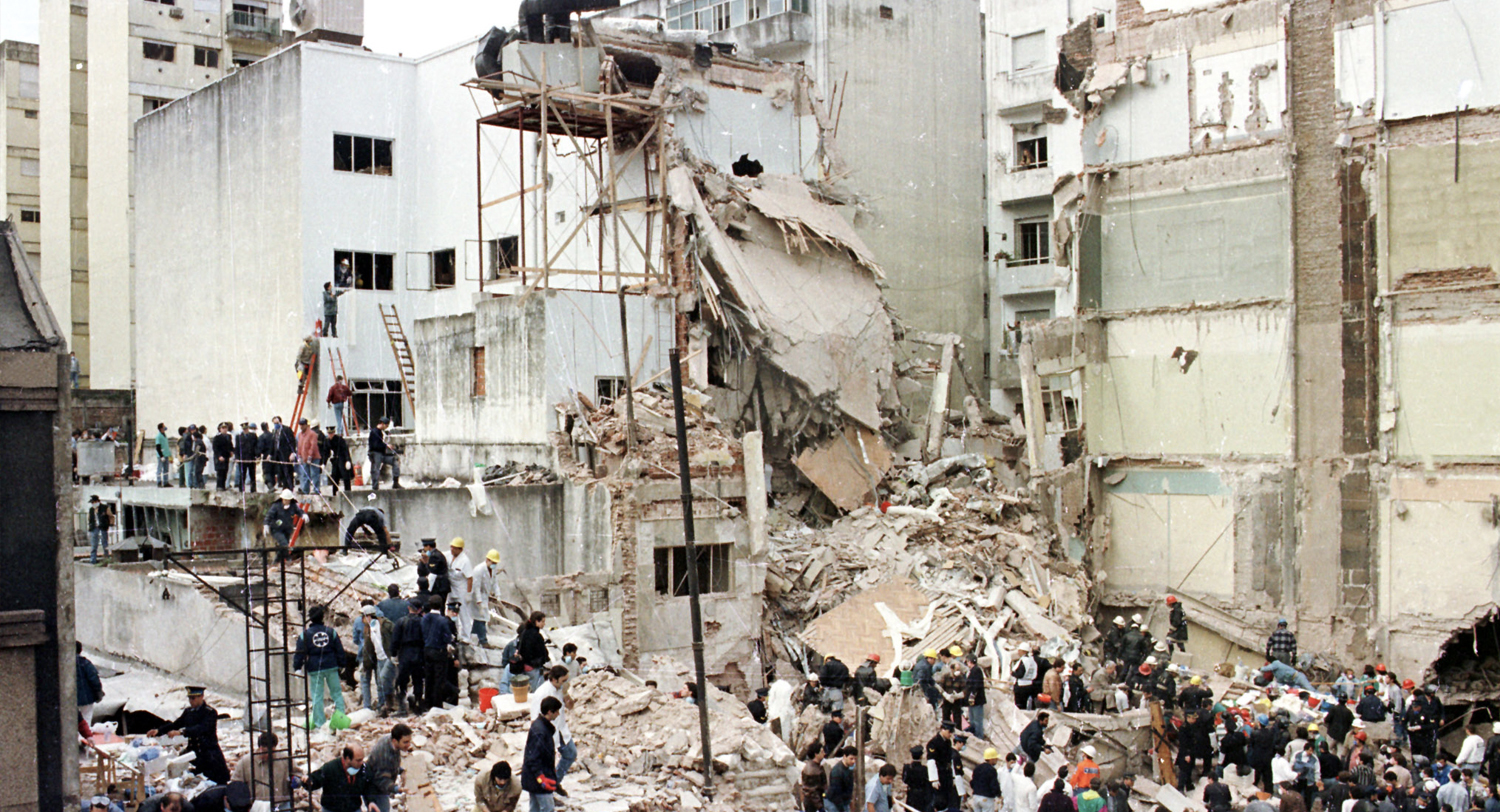The 1994 terrorist attack on the AMIA Jewish community center in Buenos Aires left 85 dead. While the prospect of bringing Iranian suspects to face justice in Argentina remains remote, there have been important judicial developments over the past 18 months. This could lay the groundwork for further international pressure on Iran.
Background: A Building Bombed, An Investigation Diverted, A Prosecutor Dead
On July 18, 1994, a van loaded with explosives was driven into the headquarters of the Asociación Mutual Israelita Argentina (AMIA), the country’s principal Jewish community organization, causing 85 deaths and 300 injuries. It came two years after a similar attack on the Israeli embassy in Buenos Aires caused 29 deaths and 242 injuries.
The judge in charge of the investigation, Juan José Galeano, focused initially on Iranian involvement. But then he pointed to a “local connection” involving members of the Buenos Aires Provincial Police which proved to be a false trail. Galeano himself (along with the head of Argentina’s intelligence service and other officials) was ultimately convicted of authorizing a payment to an individual to substantiate this thesis, and in turn ignoring the role of a Syrian businessman living in Argentina possibly linked to Hizbullah and Iran.
In 2004, federal prosecutor Alberto Nisman took over the case. He pursued the Hizbullah/Iran connection, identifying two Lebanese and seven Iranians as involved in perpetrating the crime. Nisman sought to interrogate the Iranians, including former President Ali Akbar Rafsanjani (since deceased). However, while Interpol red notices were issued against them, they have never been made available by Iran for questioning in Argentina.
In a development which jolted Argentine political life, on January 14, 2015, Nisman initiated charges against then-President Cristina Kirchner and other senior government officials for treason, asserting that they had illegally attempted to orchestrate a cover-up of Iran’s role. Kirchner’s government had negotiated a bilateral “memorandum of understanding” with Iran under which Iran would agree to make available for questioning those individuals whom Nisman had sought, but only in Iran and only by jointly approved investigators.
Four days later, on January 18, 2015, Nisman was found dead of a gunshot wound in his Buenos Aires apartment, immediately before he was due to testify before a Congressional committee regarding his investigation. His apartment was not properly secured, and multiple individuals from different law enforcement and intelligence agencies apparently entered it after his death. Argentine authorities, from Kirchner on down, termed his death a suicide, a view that further investigation has discredited.
In January 2025, a report by the National Prosecutor’s Office details the failure to properly secure Nisman’s apartment, the many missteps in the investigation and the unaccounted for presence at the crime scene of personnel from various intelligence agencies. It concludes: “Nisman was the victim of a homicide and his death was motivated by his work in the AMIA Investigation Prosecution Unit and concretely his work linked to the memorandum of understanding with the Republic of Iran.”
Inter-American Court Criticizes Initial Argentine Handling
On January 26, 2024, the Inter-American Court of Human Rights published a scathing opinion in a case brought by “Memoria Activa,” a civil society organization dedicated to achieving the truth regarding the AMIA attack. Its findings included:
—Judge Galeano authorized payment of 400,000 dollars of secret funds of SIDE (the Argentine State Secretariat of Intelligence), to Carlos Telleldin, the car dealer who had sold the vehicle used in the attack, to have him implicate members of the Buenos Aires Provincial Police.
— Judge Galeano “discontinued, interrupted and delayed” investigation of the possible role of the Syrian businessman in the attack.
— The Argentine government had “knowledge of the possibility of an attack in the country,” constituting a “real and immediate risk” to sites associated with the Jewish community, but “reasonable measures to avoid this risk” were not taken.
— In sum there was “a grave failure to investigate one of the largest terrorist attacks in the history of the region.”

Argentine Criminal Appeals Court Names Hizbullah and Iran
On April 11, 2024, Argentina’s Federal Court of Criminal Cassation, an appellate body which reviews cases brought in Argentina’s federal courts, issued two rulings in the AMIA case. First, it dismissed the case against car dealer Telleldin in the pursuit of the discredited “local connection” theory.
Second, the court concluded that “there are diverse and solid references which confirm the linkage between both cases [AMIA and the 1992 attack on the Israeli embassy] and the responsibility of the terrorist organization Hizbullah and the financing, logistics, and orders for their implementation by those who then led the Islamic Republic of Iran.”
The court noted Hizbullah’s presence in the Argentina-Paraguay-Brazil tri-border area, as well as the threat posed by Iranian-linked aircraft using Argentine airports for logistical purposes in maintaining connections with Hizbullah.
In a separate ruling (an appeal by Judge Galeano and others charged with embezzlement in promoting the spurious “local connection” theory), the court delved into Iran’s role in international terrorism. It noted that a “Syrian connection” had led to Mohsen Rabbani, an Iranian cleric with connections to Hizbullah, who was sent to Argentina nominally as cultural attaché, but in reality to proselytize for the Islamic Revolution.
It also reviewed other terrorist attacks from Beirut to London, Paris, Kuwait and Bangkok, which have been attributed to Hizbullah and Iran, discussing the role of Iran’s Ministry of Intelligence and Security and the use of its diplomatic establishments to facilitate “the provision of documentation and… the transport of weapons to intelligence networks in infiltrated countries.”
The court also considered one possible theory that Iran may have launched the AMIA attack as a reprisal for Argentina’s 1991 decision to end collaboration between its state nuclear power enterprise and its Iranian counterpart. The attack was possibly “an extreme form of pressure so that [Argentina] would reverse, as a result of coercion and the lethality of its results, its decision to cancel these contracts.”
Supreme Court Allows Treason Case Against Kirchner to Proceed
Perhaps the most startling development in the AMIA legal saga has been the decision of Argentina’s Supreme Court, in December 2024, to allow the treason case against former President Cristina Kirchner and other senior officials to proceed.
The treason case focuses on the Kirchner government’s memorandum of understanding with Iran, which would have established a “truth commission” of international lawyers, two chosen by Iran, two by Argentina, and one jointly, to question Iranians in Tehran and subsequently issue a report.
But the Supreme Court also stated that “the accusations are not reduced to the signing of an international agreement but … include other negotiations conducted through “parallel channels”… consistent with providing impunity to Iranian citizens.” [The “parallel channels” refer to the activities, cited by Nisman, of Peronist figure Luis D’Elia and Fernando Esteche of the far left “Quebracho” movement in promoting negotiation of the memorandum with Iran.]
The treason case was initially dismissed by a trial court. On appeal, the Court of Cassation rejected various arguments, including that negotiating a bilateral agreement raised a “non-justiciable political question.” The court ruled that the trial court dismissal was “arbitrary” and “capricious,” and a trial had to go forward.
There is only one case of a treason charge ever leading to conviction in Argentine history and the outcome of former President Kirchner’s trial remains difficult to predict.
The New Prosecutor Charges Iran’s Supreme Leader
In April 2025, Sebastián Basso, the federal prosecutor who now heads the AMIA investigation, formally sought the arrest and extradition of several Iranian officials, most notably Supreme Leader Ali Khamenei, whom he accused of having “headed the decision to perpetrate a bomb attack in Buenos Aires in July of 1994 and (having) issued executive order (fatwa) 39 to carry it out.” He argued that Khamenei did not enjoy sovereignty immunity from prosecution in Argentina, since the case entailed terrorism and human rights violations,
The Iranian government responded by summoning the Argentine chargé d’affaires in Tehran to express its displeasure and assert that Iran would take all “necessary legal and political measures to protect its interests under international law.”
Whether Iran will engage local counsel in Argentina to challenge this request or simply ignore it, as it has done in the past regarding this case, remains to be seen. It is unlikely that Argentine courts will approve Basso’s efforts against a sitting head of state, which would break with the general principle of sovereignty immunity in national courts for actions of foreign governments.
Building a Record
The victims of the 1994 AMIA attack have not received justice. With many of the responsible individuals residing in Iran, we are unlikely to see this case resolved soon. Nevertheless, international and Argentine courts and Argentina’s prosecutor are building an important record of individuals (Argentine, Iranian and Hizbullah) who are complicit in this attack and its cover-up. This judicial record will provide a basis for further international pressure on Iran in the short term and ultimately may lead to justice in this long unresolved case.



